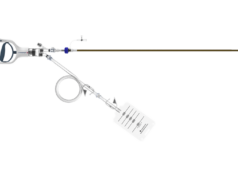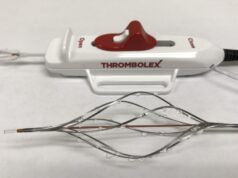
Lowell S Kabnick, associate professor, NYU Langone Medical Center, New York, USA, has worked to develop minimally invasive systems for the treatment of varicose veins. His proudest moment was the development of the TreSheath device, which carries the laser fibre and improved the safety of the endovenous laser ablation of varicose veins. Kabnick tells Vascular News about his career, his areas of research and his opinions on trends in venous disease management.
When did you first decide you wanted a career in medicine and why did you decide to enter into vascular surgery and specialise in venous disease?
As far as I can remember, I have always wanted to be a physician. My father was the youngest of four sibling doctors. Dad, a paediatrician, would occasionally take me up to the hospital to show me an X-ray or talk to me about some of his patients. I saw how loved my father was by his patients and the respect that he had in our community. In addition to being a loving father, he was a mentor and role model. The idea of becoming a physician was easy; however, would I be able to have the perseverance to achieve this vocation? After completing George Washington University, I continued on to finish at their medical school. There was never a doubt that I wanted to become a surgeon. What I did not know was what type of surgeon I would become. During my surgical residency at NYU, I developed an interest in extremity replantation. I spent hours in the lab practicing microvascular technique. However, my interests began to shift as the need for an extremity replant surgeon was limited. I thought about reconstructive free flap surgery and indeed was accepted for a position in plastic surgery residency. However, in my fourth year of general surgical training, I had a change of heart. After participating in many major arterial reconstructive and venous surgical procedures, I decided to follow that pathway. Dr Julius H Jacobson, Chief of Vascular Surgery at Mount Sinai Hospital, New York, offered me the opportunity to complete my vascular specialty training. In 1986, I established the Vein Center of New Jersey and never looked back.
Who have your greatest surgical influences been and what advice from them you still remember?
Dr Jacobson is a bright and masterful technician who improved my technical craft. I can still hear him today as I strive for surgical perfection. It was Harry Shanzer, whose varied vascular interests included venous diagnosis and treatment, who influenced me to embrace this part of vascular surgery. Dr Frank Spencer’s compulsive attention to patient care details continues to resonate with me and in turn with my residents and fellows. Dr Seshadri Raju with his quest for understanding deep venous pathophysiology, the pioneering of percutaneous repair of venous outflow obstruction, has redirected and stimulated my exploration of deep venous disease. Lastly, I would be remised if I did not mention Dr Frank Veith for his support of my career and the wisdom that he imparts.
On a professional level, what have your proudest moments been?
- When my father handed me my medical diploma at graduation.
- In 1998, recognising that endovenous thermal ablation would pave the way for significant changes in venous intervention.
- Being accepted and recognised by my peers as an expert in the field of venous disease.
- Being the first vascular surgeon in the USA to use radiofrequency ablation to close the great saphenous vein (1999).
- To have the conviction and fortitude to continue with the pioneering of endovenous thermal ablation even though many of my colleagues were nay sayers.
Can you please tell us about the first endovenous procedures you performed?
Just after endovenous radiofrequency received its FDA approval, I performed my first case. Prior to performing this case, I was instructed by the company’s engineer. Since I was going to be the first surgeon in the USA to perform this procedure and had limited experience in ultrasound access guidance, I thought the optimum locale would be the operating room under general anaesthesia with ultrasound guided intracompartmental anaesthesia. The procedure went smoothly and relatively rapidly.
I was elated. On the way to recovery room, the patient asked when she could have the other leg “operated upon?” I was amazed as no patient having had prior ligation and stripping had asked that question. What was more amazing was the shortened recovery period, significantly decreased pain and bruising in comparison to the standard stripping procedure.
You have been involved in several trials of different modalities for the minimally invasive treatment of varicose veins. With so many techniques available, how do you help your patients choose the best treatment? Also, which of these modalities do you use most?
In my clinical trials at NYU with 1470nm wavelength laser with a jacket-tip fibre (NeverTouch, AngioDynamics) for truncal ablation of a superficial refluxing axial vein, both laser and radiofrequency are equivalent in efficacy and postoperative recovery. The jacketed fibre is more important than the wavelength for postoperative recovery. With that being said, I use both laser and radiofrequency. For perforator ablation, I only use laser as it is efficacious, easier and quicker than radiofrequency. For treatment failures, I use laser as it is more versatile than radiofrequency in that I can spot weld areas and it has a smaller profile with several different kit options. I have no preference with regards to treating truncal insufficiency.
Of all the procedures you have developed for varicose veins and spider veins, which one are you proudest of and why?
I have simplified and improved the efficacy and safety profile of both laser and radiofrequency. My proudest moment was the development of the TreSheath (AngioDynamics) to carry the laser fibre to facilitate and improve the safety profile of the procedure.
Polidocanol endovenous microfoam is expected to be approved soon. What is your experience with the study of this new agent and how promising do you think it is?
Concerning polidocanol endovenous microfoam (PEM, BTG), I participated in the phase 3 FDA trial. PEM chemical ablation of the great saphenous vein demonstrated excellent efficacy and safety. During the trial a unique patient reported outcome (VVSymQ) was utilised which revealed significant symptom improvement. In summary PEM has promise and appears to be safer than room air foam.
In your opinion, what are the main trends in venous intervention at the moment and what new developments can we expect to see?
The main trends in venous intervention involve both deep and superficial systems. With regard to the deep system, the nuances of pharmomechanical therapy, new oral anticoagulants and the development of venous stents are the principal areas of focus. Superficial ablation is moving away from tumescent anaesthesia, using foam sclerotherapy, pharmomechanical ablation and cyanoacrylate. However, I must caution physicians that these newer procedures may not be superior to the thermal which require tumescent, regional or general anaesthesia. The holy grail for venous devices: 1) non-invasive non-thermal tumescentless venous ablator; 2) non-invasive or minimally invasive restoration of vein competency; 3) percutaneous endovenous valve, and 4) the perfect endovenous stent.
A number of new oral drugs are being used for venous thromboembolism and could potentially replace warfarin. Will we see this happening in the near future?
Until there is an antidote for the new anticoagulants, I believe there will be continued reluctance by the surgical community for adoption. The fear of uncontrolled bleeding and the difficulty controlling surgical bleeding lead the causes for refutation. That being said, the efficacy and the safety profile appear to be better than warfarin with distinct advantage of no level testing.
What are your current areas of research?
My current areas of research involve endothermal h eat induced thrombosis (EHIT)—natural history and importance; and patient reported outcome data (VVSymQ) with regards to deep venous obstruction.
Outside of medicine, what other interests do you have?
Outside of medicine, my interests are water sports-sailboat racing (sunfish), scuba diving, and powerboat motoring. I have been known to sculpt, play tennis and encourage the equestrian sport of Show Jumping.
Fact File
Education
1972 BA, Speech Pathology and Audiology, George Washington University
1976 MD, Medicine, George Washington University
Postdoctoral training
1976–1978 Intern in General Surgery, New York University, Bellevue Hospital, New York, USA
1978–1980 Resident, General Surgery, Long Island Jewish Medical Center, New Hyde Park, USA
1980–1981 Chief resident surgeon, Long Island Jewish Medical Center, New Hyde Park, USA
1981–1982 Fellow, Vascular Surgery, Mt Sinai Hospital, New York, USA
Certification
1982 American Board of Surgery, General Surgery Certificate
2008 American Board of Phlebology
2010 Cardiovascular Credentialing Registered Phlebology Sonographer
Academic appointments
2007 Associate professor, NYU School of Medicine
2007 Associate professor, University of Medicine & Dentistry of NJ
Hospital appointments
1982 Attending physician, Morristown Hospital Center, New Jersey
2007 NYU Langone Medical Center
Editorial positions
Editorships:
2009 Associate editor, Phlebology Forum
2010–present Assistant editor, Journal of Phlebology
2012–2013 Editor, Practical Phlebology series, “Duplex Ultrasound and Deep Venous Thrombosis”
Editorial Boards:
2008–2013 Journal of Phlebology
2008 Journal of Certified Wound Specialists
2012–2013 Vascular Medicine









